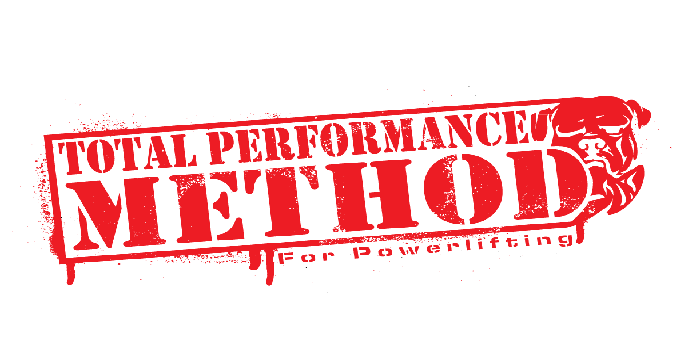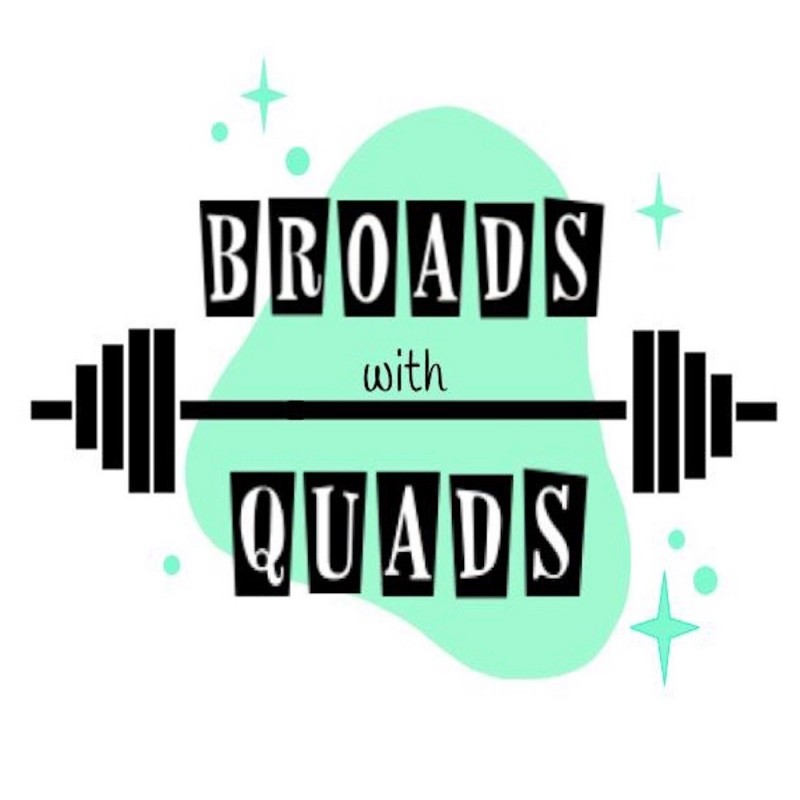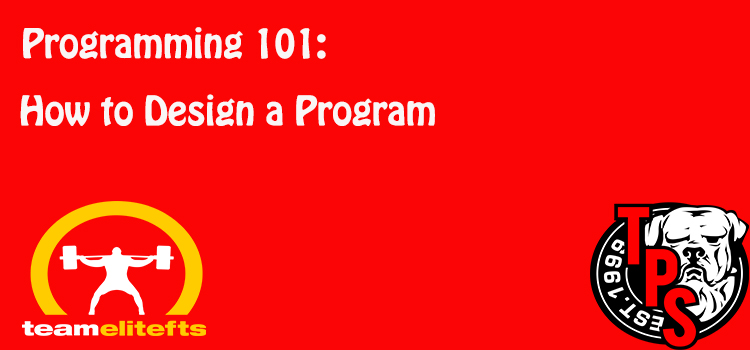
Over the years I’ve spoken with lots of coaches and presented at lots of seminars, and when I ask people what they need the most help with, programing is by far one of the most common things I hear.
Today, I’ll try to demystify how to write a program.
There are many styles of programming and guess what?
They all work.
Look, even a shitty program will produce results if you work hard.
That’s the key, hard work.
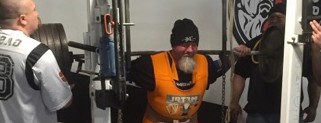
But, a well-designed program will work better, especially if you work hard at it.
And, to truly know how well a certain style of programming works for you, you have to work at it for at least six months, and FOLLOW it.
Don’t try a program or style of programming for four weeks, see no results and say it didn’t work. It takes time to see a result. It takes effort.
It also takes buy in.
If you embark on a program, you have to believe it will work.
If you don’t believe, it you’ve set yourself up to fail.
Trust in your coach, or the person you got your program from.
Note: This only applies of you have a legitimate coach or bought a program from someone legitimate.
If you got your program on Instagram for $9.99 from someone who looks buff and jacked and has 100,000 followers, or from a lifter with a big total, that doesn’t necessarily mean they know how to write a program or are a coach.
A lot of times you’ll see the lifter with the huge total has their programs written by someone else.
Hmm…..
OK, with that out of the way, let’s move on.
I’ll explain how I approach programming.
I program with the big picture in mind, not the short term.
We look at the meets the lifters will be doing over the year and if there is one that is more important than another, for example, a qualifying meet and then the big meet we program accordingly.
We may not know when the meets are yet, as they may not have been posted. A good example of this is meets for 2019 will not be posted until at least the end of 2018. We have to have some idea as to then they are though.
You can write your plan out with a timeframe in mind. A great example is that we know certain meets, like the Arnold are always around the same time. A program can be written with that long-term goal in mind and then tweaked once the date is announced.
I write in 8-week blocks.
Some write in 4-week blocks, some 10, and so forth.
As long as there is a plan and you aren’t writing random blocks with no plan you are ok here.
Your blocks should build off the previous block and they should accommodate for what happened in the last block.
Let’s say that you don’t really refer to your old blocks and don’t really plan, and your lifter just finished 6 weeks of heavy volume and you just realized that their new block is due tomorrow, you can’t not refer to the last one.
If you throw them into intensity with no type of deload, chances are they will fail, or get hurt.
Let’s look at deloads too.
I am not a fan of deloads as they are done by many.
I like to do a volume or an intensity deload every few weeks.
Not a true deload where they take 3 sets of 5 at 65% as an example.
If it’s a volume deload, we will drop about half of the assistance/accessory work for a week.
If it’s an intensity deload, we will reduce the total lifts by some, but not lower the intensity much.
I’ll explain this a bit more in later articles.
Do I need to review Volume and Intensity?
OK.
Here it is as unscientific as I can make it.
Volume waves have the lifter handling 65%-80% for the most part for more reps.
Reps will be in the 4-8 range usually, with about 5 being nice.
Intensity waves will be done at higher percentages, usually 75%-95%, or maybe even a bit higher for far less reps and sets. Reps stay under 3 for the most part and sets are usually around 3-5.
There is more to it than that, but I said simple and unscientific in my intro.
Programming 101: How to Design a Program-Now, onto the science.
I use a combination of percentages and RPE.
I used to use exclusively percentages, and then switched to RPE. Now, I find that a combination of the two works very well, even better than other approaches I’ve used.
When using RPE only, lifters will frequently overshoot or undershoot the RPE and the program doesn’t work.
Constantly undershooting RPE’s leads to stagnation and no improvement.
Constantly overshooting RPE’s leads to injury, burnout. It’s a bad scene.
The beauty of RPE is that if you are having a great day, you can lift more, and if things are going bad, you can scale back. When the lifter truly understands how to gauge RPE, it works well.
When they don’t, it sucks, it just doesn’t work.
Switching to a percentage based program, similar things apply.
When training on a percentage program you have to hit the required lifts at the required percentage in order to get the most out of it.
Let’s say that you have a new baby at home and they aren’t sleeping, and you only got four hours of sleep and you got stuck at work for an extra four hours; chances are your performance will be affected that training day.
65% might feel like 85%. Too bad, you’ve got to hit your numbers.
On the other hand, let’s say every extrinsic factor in your life is 100% on point and you are firing on all eight cylinders.
You hit the gym and 80% feels like 50%.
Too bad. You have to hit the numbers.
You can’t go up.
Both systems have advantages and disadvantages.
My combination (and others do this too, I am not saying I invented this) of RPE and percentages accommodates for good and bad days.
I assign an RPE with a percentage.
EG:
Volume Wave:
4x5 RPE 9 at 75% (+/- 2 ½-5%)
If the lifter is having an AWFUL day, we drop to 72.5%.
If it still sucks, we drop to 70%.
Or, if they are having an AWESOME day, we go up to 77.5% and maybe 80% for the last set.
This almost always solves the issue presented to us.
It also allows the lifter to stick to the RPE, no overshooting or undershooting.
Now, how to figure out the numbers.
This is where the art and the science meet.
I use an RPE chart as well as Prilipen’s chart to determine the number of reps to be done, the percentage to work at and the RPE assigned.
I work in blocks of Volume and Intensity with the waves usually going about 3-4 weeks each before moving to the next.
If we are doing a 4-week Volume wave, I’ll add in a week of Volume deload where we lower assistance/accessory work to allow for recovery and then move into the Intensity wave for 3-4 weeks.
At the end of that wave, we do an intensity deload and go right back to Volume.
I’ve been using this method for a long time and it works well for us.
They stay injury free for the most part, they realize consistent improvement and that keeps them training.
Of course, injury is part of the sport and most lifters will face one at some point. Our job is to do our best to prevent this and at the least, minimize the risk.
Balancing intensity, volume, tonnage, frequency and recovery is just as much the coaches job as the lifters.
Lifters need to follow the program and not go off book.
You know what I mean, we’ve all seen the lifters who max out when they aren’t supposed to and it hurts them on meet day. Or the next day.
Back to the science, or maybe art.
First, for the purpose if writing a program the way I do, you need to know if you are writing a Volume or Intensity block. Even if you don’t write the way I do, you will be doing Volume and Intensity work even if you don’t call it that.
EG: A Circa Max wave in a Conjugate program is about as INTENISTY as it gets.
OK, we have it figured out, we are working on a Volume block here.
Let’s assume they are “off season” and we want to get them stronger and keep the intensity lower for a few weeks, sets of 4-5 reps will fit the bill.
We refer to our charts and set up sets and reps as we like.
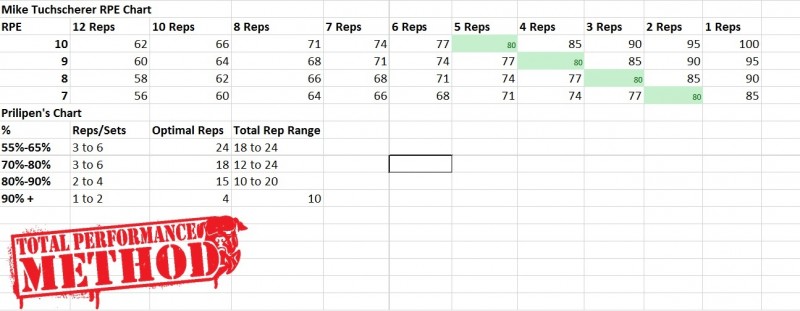
A set of 5 reps can range from an RPE 7 to an RPE 10 depending on the percentage.
As you can see in the chart, 5 reps at an RPE 7 is about 70%, and 5 reps at an RPE 10 is about 80%.
These are guidelines and are pretty accurate.
When writing the program, I tend to start at a lower RPE/percentage with more sets and progress to a higher percentage with less sets.
And, I round to the nearest percentage in increments of 2 1/2%.
EG: if the chart says 71%, I round to 70%, if it says 63%, I round to 65%.
It would look something like this:
- Week 1: Squat 5x5 at RPE 7/70% (+/- 2 ½-5%)
This means that we start at the 70% and if it is a good day, and it feels easy, add 2 ½% for the next set.
If that is still too easy because you are en-fuego, add another 2 ½%. Don’t go crazy and add more than 5% no matter how good it goes.
- Week 2: Squat 4x5 RPE 8/75% (+/- 2 ½-5%)
- Week 3: Squat 5x4 RPE 8/77.5% (+/- 2 ½-5%)
- Week 4: Squat 4x4 RPE 9/ 80% (+/- 2 ½-5%)
- Week 5: Volume Deload Squat 4x4 RPE 8/ 75% (+/- 2 ½-5%)
If we then look at Prilepin’s chart you can see that the rep ranges for 70%-80% are 12-24 total reps with the sweet spot at 18 reps.
For 80%-90% the ranges are 10-20 with the sweet spot at 15 reps.
In Week 1, the reps are at 25 total, that puts us 1 rep over the total but as it is 70%, it is just fine.
As we progress to Week 2, reps are at 20 total, they are reduced because the percentage is a little higher.
Week 3 we see the total reps stay the same but the number of reps per set decreases due to the higher percentage. We are still in the 12-24 reps zone as suggested by the chart, but dropping one rep per set keeps technique strong, ideally. If it is not, we drop 2 ½% to keep it there.
Week 4 sees the intensity go to 80% and total reps to 16. As you can see in the chart, 15 is perfect, so we are right there.
We need to make sure that form and technique are consistent rep to rep and set to set.
If the form breaks down, adjust weights accordingly.
One thing coaches realize, and newer lifters miss a lot is that your RPE will vary set to set, especially as you progress to the end of the training.
Your first two sets may have been a 7, and when fatigue sets in, you may have to lower it.
On the other hand, you also see that as lifters get warmed up and dialed in during the session, the third or fourth set may be the best one. Maybe increase if the last set was easy.
This is where the art of coaching separates from the science.
How about an example of an Intensity wave?
Ok, here it goes.
- Week 1: Bench Press 6x3 RPE 7/ 75% (+/- 2 ½-5%)
- Week 2: Bench Press 5x3 RPE 8/ 80% (+/- 2 ½-5%)
- Week 3: Bench Press 4x3 RPE 9/ 85% (+/- 2 ½-5%)
- Week 4: Bench Press 3x2 RPE 9/ 90% (+/- 2 ½-5%)
- Week 5: Intensity Deload Bench Press 4x3 RPE 8/80% (+/- 2 ½-5%)
And again, if you look at Prilipen’s chart, you will see the total lifts correspond with the sweet spot for the most part.
Another thing to remember is that form and technique are never to be compromised for weight.
Yes, we want to move the most weight possible, but if we are moving the weight with shitty patterns, squatting high, ass popping off the bench, of hips rising faster than the shoulders, we need to adjust and fix the technique issues.
This is why we have the +/- percentage factor built in.
Coaches, objectively look at your lifters and do not let YOUR excitement or ego get in the way of their success.
It is your job to mange the lifter. Make them do things properly.
You are doing them no favors if you blow smoke up their asses and tell them high squats look good.
They will fail under proper judging.
If you squat high in the gym, you’ll probably squat higher at a meet.
Do your job.
As coaches we also need to have the ability to change the plan if the need arises.
That too will be the topic of another post.
I hope this has shed a little light on programming your main lifts and how to use RPE and Prilepin’s chart to guide you.
Again, this is not the only way to program, it’s how I do it.
Please use this and let me know how it works for you.
AND:
The Broads are back.
Our ladies in the TPS Method for Powerlifting dropped another new podcast on the iTunes.
It’s pretty funny and is full of good info for new lifters.
AND:
It’s the last week of the Gofundme drive for the Pioneer Charter School’s weight room.
If you can spare a few bucks, please donate.
Ask me a question-Be sure and Type to Murph in the header
Find me on Google-search for Total Performance Sports Malden, Mass. The Best Gym in Boston, Facebook too.
Oh, yeah, follow us on Instagram too. TPSMalden
SHARE THIS!
#bostonsstrongest
Vincere vel mori









